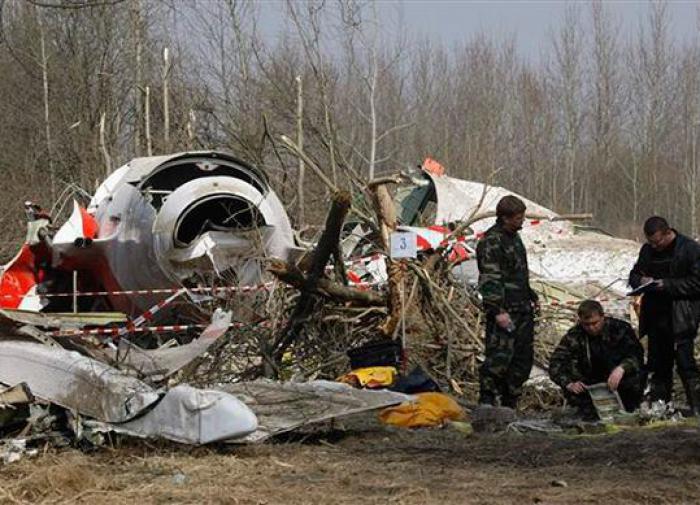The Polish commission to re-investigate the crash of the Tu-154 airliner of Polish President Lech Kaczynski claims that the TNT, the explosion of which allegedly caused the crash, had been placed on board the during its repairs in Russia.

The Tu-154 plane crashed on April 10, 2010 while landing at the airport of Smolensk, Russia. There were 96 people on board: 88 passengers and eight crew members. They were flying to Russia to take part in memorial events in Katyn, where in 1940 thousands of Polish prisoners of war were killed. The crash left no survivors.
In 2011, the Interstate Aviation Committee published the final report of the results of the technical investigation, according to which the primary cause of the crash was the decision of the crew not to leave for an alternate airfield. Deficiencies in flight support and crew training were named as secondary reasons that led to the tragedy that killed almost the entire Polish administration.
The first Polish commission, led by former Interior Minister Jerzy Miller, came to similar conclusions. According to the conclusions of Miller's commission, the airliner crashed because it descended below the allowed minimum despite thick fog. The report also pointed out the "mistakes" of Russian dispatchers at the Smolensk airport. However, the Polish authorities did not agree either with the IAC report or the conclusions of the Miller Commission and decided to set up a second commission to continue the investigation.
The new commission led by former Polish Defense Minister Antoni Macherewicz published an interim report Friday, July 31, summarising several years of its work. The report states that the plane crashed as a result of two explosions in the left wing and in the central part of the plane. The nature of the damage caused to the aircraft and the scattering of its debris, as well as the nature of the injuries sustained by the people on board, prove the explosions, the Wiadomosci publication said.
- Many bodies were ripped into pieces
- 74 percent of the bodies were completely or partially deprived of their clothes, as if they were exposed to a blast wave.
- As many as 47% of the bodies were badly burned.
- To crown it all, many of the victims had foreign objects in their bodies - fragments of aircraft covering, glass and even steel structures.
According to the Polish version, the first explosion destroyed the left wing of the aircraft. Then a second bomb went off planted next to the so-called "general's compartment" in the central part of the liner. It was the second explosion that supposedly killed all the high-ranking passengers in this compartment of the airplane.
Polish experts deny the version about the collision with the ground, having claimed that their extensive evidential base, including countless experiments and analyses contradict to such version. The report also says that Russian investigators took steps to conceal the true causes of the plane crash.
The Polish commission claims that the presence of traces of explosives on board - TNT, pentrite and RDX (hexogen) - was confirmed by experts of US and British laboratories where the analyses were carried out. It was noted that traces of explosives were found in the samples that were taken from parts of the aircraft that Russian technicians had replaced during the repairs of Tu-154 N 101 (Kaczynski's aircraft) and Tu-154 N 102 (another Polish-owned aircraft) in 2009.
"In this case, a laboratory in Oregon (USA) revealed the presence of TNT. It should be noted that it was a part that no one had repaired before, except for repairmen, and traces of TNT were found inside it," the report from the Polish commission says.
Polish has been insisting on the version of the bomb explosion on board Lech Kaczynski's aircraft since 2016. To search for traces of explosives, the bodies of the victims of the tragedy, including the body of Lech Kaczynski, had been exhumed. A number of Polish experts stated that the autopsies carried out had not confirmed the version of the explosion on board the aircraft.
Russia denies the version about the explosions. Svetlana Petrenko, an official spokesperson for the Investigative Committee of the Russian Federation, noted that such statements were yet another awkward attempt to question the obvious.
According to Petrenko, no traces of explosives were found either on the fragments of the Tu-154M aircraft, or on the remains of the dead. Moreover, the substances that are not typical for the materials of structural elements of the aircraft and the products of its operation were not found either. Petrenko stressed that the Russian investigation had no doubts about the circumstances of the plane crash. Given the difficult weather conditions at the moment of landing, the aircraft captain should have decided to take the aircraft to an alternate airfield, but he chose not to. It was the subsequent erroneous actions of the crew that continued the landing operation under conditions of zero visibility and did not respond to the terrain awareness and warning system that caused the tragedy to occur, Russian investigators believe.
No comments :
Post a Comment